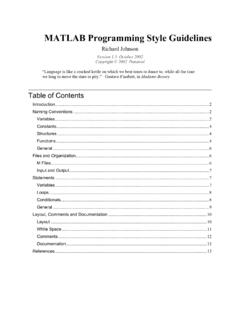Transcription of Pengantar Riset Pemasaran - Universitas Indonesia
1 PengantarRisetPemasaranDefinisi PemasaranPemasaranadalah suatu proses sosial dimana ada kelompok masyarakat ataupun individu ingin memenuhi kebutuhan dan keinginannya melalui suatu kegiatan menciptakan, menawarkan dan mempertukarkan secara bebas produk ataupun jasa yang bernilai dengan pihak lain-Philip Kotler (p. 7)Proses Manajemen PemasaranNeeds, wants and demandsProductsValue, cost and satisfactionExchange, transactionand relationshipMarketMarketingNeeds, Wants, and Demands Needsmenggambarkankebutuhandasarmanusias epertipangan, sandang, papan, pendidikan, kesehatan, rekreasi, dll Needsmenjadiwantsjikakebutuhantelahmenja disatukeinginanyang tertentuyang dapatmemberikankepuasan.
2 Demandsadalahwants(keinginan-keinginan)t erhadapproduk/jasayang company effort: Total usahaperusahaanCustomer Satisfaction: KepuasanPelangganTotal CompanyEffortTheMarketing ConceptEffortCustomerSatisfactionRencana danStrategiPemasaranRencanaStrategiTakti kNilaiBerhasil/SuksesAnalisa globalAnalisa lokalAnalisa jenis usahaAnalisa SWOTT ujuan UsahaSegmentasiTargetingPositioningDifer ensiasiMarketing MixSellingMerkPelayananManajemen Masyarakat senantiasa mengharapkan ide-ide, temuan baru atau inovasi dari pengusaha, perusahaan ataupun lembaga lainnya yang menawarkan produk/jasa melalui suatu proses penelitian dan pengembangan teknologi (International Small Business Congress, 2000)
3 PeranRisetPemasarandalamRencanadanStrate giPemasaranRISETNo GoNo GoNo GoNo GoNo GoCiptakan ide-ide Pilih ide-ide Uji dan Pengembangan KonsepPengembangan & Strategi PemasaranAnalisis BisnisPengembangan ProdukTes PasarKomersialisasi MenurutMaholtradalamAmerican Marketing Association (AMA) mengatakanbahwarisetpemasaranadalahident ifikasi, pengumpulan, analisis, dan penyebaran(pembagian) informasiyang sistematisdanobjektifuntukmeningkatkanpe ngambilankeputusanyang berhubungandenganidentifikasidansolusima salah-masalahdankesempatan-kesempatandal ampemasaran. Hasildaririsetpasarakanmenghubungkananta rapemasardengankonsumendengancaramenyedi akaninformasipentingyangdapatdigunakanun tukmenyelesaikanmasalahterkaitpemasarans ertamembantudalampengambilankeputusanpem asaran.
4 PasarKlasifikasi Riset PasarThe Market Research ProcessSignificant difference in type of analysis according to whether market research is quantitative or qualitativeCommentsDistinguish between the research type needed on -budget-data sources-research approaches-research instruments-sampling plan-contact methodsInformation is collected according to the plan ( it is often done by external firms)Statistical manipulation of the data collected ( regression) or subjective analysis of focus groupsOverall conclusions to be presented rather than overwhelming statistical methodologiesIf a problem is vaguely defined, the results can have little bearing on the key issuesThe plan needs to be decided upfront but flexible enough to incorporate changes/ iterationsThis phase is the most costly and the most liable to errorCan take various forms:-oral presentation-written conclusions supported by analysis-data tablesSteps1.
5 Defining the problem and objectives2. Developing the research plan3. Collecting the information4. Analysing the information5. Presenting the findingsPrimary researchPrimary research involves finding out new, first-handinformation. This is called primary of primary research include: Questionnaires Focus groups ObservationPrimary researchBenefitsDrawbacks Directly relevant to the business Up-to-datedata obtained Competitors do not have access to the findings Time consuming Often expensive Results may be misleadingif the sample size is too small, questions are unclear or there is interviewer biasQuantitative research Quantitative market research involves finding numerical data Quantitative data is generally collected from large samples and is easy to analyse Methods of collecting quantitative data include written and online questionnaires Qualitative research involves finding out opinions, attitudes and feelings Often more useful than quantitative data but is more difficult to collect and analyse Methods of collecting qualitative data include focus groups & in-depth interviewsSamplingSampling is the method of choosing a smaller.
6 Representative group of respondents with which to conduct research instead of the whole reduces the cost and time to carry out research. Careful sampling can provide reliable data about the methodsRandom samplingEveryone in the population has an equal chance of being chosen to be in the samplingPeople in the sample are chosen to reflect the proportions of different groups in the target market 80% over 60s, 20% under 60s when researching the market for mobility samplingThe appropriate market segment is first selected, for example, married men, then the sample is randomly selected from this of samplingThe larger the sample size, the more reliable it is likely to be.
7 However, larger samples incur greater 95% confidence level is usually expected when conducting research. This means that findings are likely to be correct 19 times out of Tools Unlikely you will use most of these techniques; list presented below for your general knowledge Other modules on Wiley web site (companion site) offer interactive exercises Statistical tools: Multiple Regression: Estimating best fitting equation showing how value of dependent variable varies with changing values in number of independent variables Example: Estimate how unit sales are influenced by ad expenditures, price and competitors moves DiscriminantAnalysis: Classifying persons into two or more categories Example: Reveal variables that discriminate between loyal and non-loyal customers Conjoint Analysis.
8 Ranking of preferences for different offers to identify relative importance of attributes to customers Example: Identify most important attributes (price, warranty, service and brand) and tradeoffs involved for end-users of a laptop computer manufacturer Statistical Tools (Cont d) Cluster Analysis: Separate data into specified number of mutually exclusive groups such that groups are homogeneous on chosen factors Example: Create five different types of technology consumers based upon purchasing behavior and recencyof purchase relative to product release date; categories may be earlier adopters, or laggards etc.
9 Multidimensional Scaling: Produce perceptual maps of competitive products or brands to measure how they stack up among each other Example: Find out how a particular brand is perceived versus other brands on trust, reliability, and quality Defining Market Opportunity, Market Segment And Target MarketTHE FIVE STEPS TO ANALYZING MARKET OPPORTUNITY 1. Identify the business environmental forces. Economic conditions and trends Legal and regulatory situations and trends Technological positioning and trends (state of the art; related R&D) Relevant social changes Natural environment (shortages ?)
10 Vulnerabilities ?) 2. Describe the industry and its outlook. Type of industry Size -now and in 3-5 years Types of marketing practices Major trends Implications for opportunity 3. Analyze the key competitors Product description Market positioning (relative strength and weaknesses, as seen by customers) Market practices: channels, pricing, promotion, service Estimated market share (if relevant) Reactions to competition Implications for opportunity 4. Create a target market profile. Levels: generic needs, product type, specific brands End-user focus; also channel members Targeted customer profiles Who are my potential customers ?



